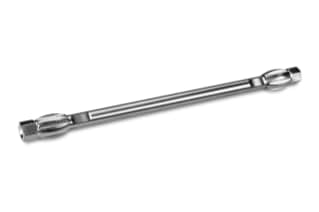
|
Chemistry |
C18 |
|
Separation Mode |
Reversed Phase |
|
Particle Substrate |
Hybrid |
|
pH Range Min |
1 pH |
|
pH Range Max |
12 pH |
|
Maximum Pressure |
6000 psi (415 Bar) |
|
Endcapped |
Yes |
|
Silanol Activity |
Low |
|
Molecular Weight Range Min |
1000 |
|
Molecular Weight Range Max |
15000 |
|
Particle Shape |
Spherical |
|
Particle Size |
5 µm |
|
Endfitting Type |
Waters |
|
Pore Size |
300 Å |
|
QC Tested |
Peptide |
|
Format |
Column |
|
Surface Area |
185 |
|
System |
HPLC |
|
Particle Technology |
BEH |
|
USP Classification |
L1 |
|
Inner Diameter |
4.6 mm |
|
Length |
150 mm |
|
Carbon Load |
18 % |
|
UNSPSC |
41115709 |
|
Application |
Peptide |
|
Brand |
XBridge |
|
Product Type |
Columns |
|
Units per Package |
1 pk |

XBridge Peptide BEH C18 Column, 300Å, 5 µm, 4.6 mm X 150 mm, 1K - 15K, 1/pk
With the XBridge Peptide BEH C18 Column, you can assess samples for proteomics over a wide pH range with low pH stability and ultra-low column bleed. Protein characterization and peptide synthesis are also possible with the lab equipment's wide-pore (300) tri-functionally bound BEH particle. For peptide separations, the XBridge BEH300 C18 Peptide Separation Technology (PST) columns have been optimized and QC verified.
Add the XBridge Peptide BEH C18 Column to your lab equipment collection to take advantage of the Protein Separation Technology of the analytical column, which integrates BEH technology and uses synthetic particles to provide the best quality and consistent performance.
To assure the stability of peptide separation processes, the XBridge Peptide BEH C18 Column is QC verified with a peptide map. This is made possible by leveraging well-known, cutting-edge bonding processes for the C18 ligand, which offer consistent results across a wide range of samples used in proteomics, protein characterization, and peptide synthesis. As a result, you may rely on the analytical column's consistency and obtain reliable synthetic peptide and protein digest separations from batch to batch. The processes utilized in the lab equipment's fabrication ensure that particle structure and bonding chemistry are stable from pH 1 to 12 and at high temperatures.
The packing materials for the XBridge Peptide BEH C18 columns were created in a cGMP, ISO 9002 accredited plant utilizing an ultra-pure reagent to give good peak shape, high efficiency, and outstanding stability. A peptide separation is performed on each batch of XBridge Peptide BEH C18 Column material, and the results are held to limited specification ranges. This is done to provide high, repeatable peptide separation performance. Every column is tested, and a Performance Test Chromatogram is included in the box with each column, along with a Certificate of Acceptance.
You can find additional Waters products that are compatible with the XBridge Peptide BEH C18 Column by browsing through our website or checking out the brochure. The website enables you to shop for lab equipment to ensure all your lab needs are met as needed. We recommend you also check out Cytochrome C Digestion Standard; The Cytochrome C Digestion Standard was prepared by digesting Bovine Heart Cytochrome C (Uniprot # P62894) with sequencing grade trypsin. Each batch of digestion standard is prepared under strict quality control criteria confirmed on the included certificate of analysis. Protein digestion standards may be used for a variety of applications, including the evaluation and benchmarking of HPLC and UPLC columns or evaluation of mass spectrometry and chromatography instrumentation performance.
What Role Does Resolution Play in Chromatography?
Resolution plays a crucial role in optimizing separations as it depends on essential factors such as peak width and retention time, which are inherent to the chromatographic process. By understanding and manipulating these parameters, one can enhance the resolution of the chromatographic analysis.